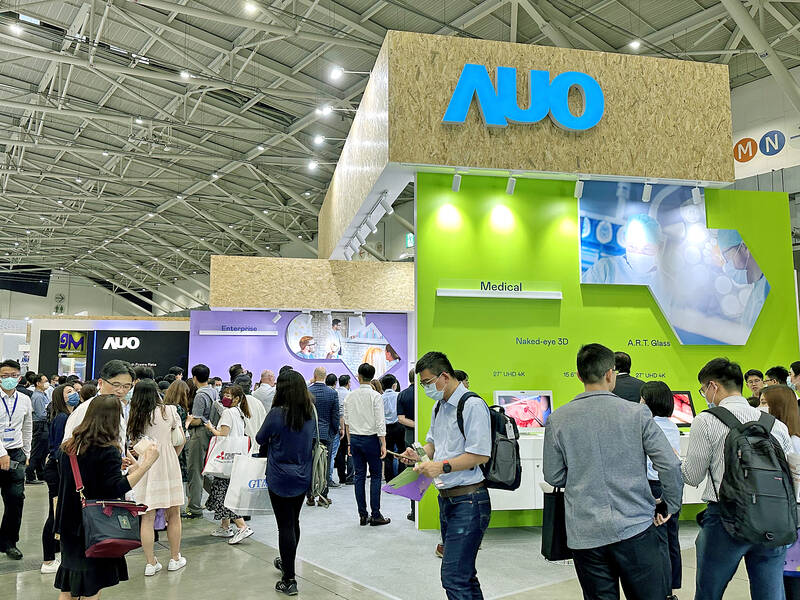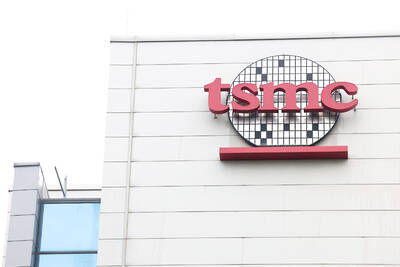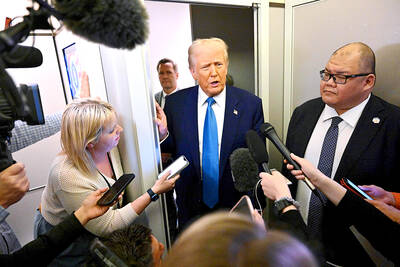Major Taiwanese LCD panel makers AUO Corp (友達) and Innolux Corp (群創) have a chance to swing back into the black in September ahead of their Chinese competitors, benefiting from further panel price hikes and free from heavy depreciation expenses, market researcher Omdia said.
The researcher expects the prices of TV panels to climb about 3 to 5 percent this month, extending a dramatic uptick in the first few months of this year, while the prices of panels used in computers and monitors have started picking up this month by about 3 percent.
Last month, manufacturers raised prices for computer and monitor panels on their distribution networks for the first time since the industry slump in the second half last year due to a severe surplus, Omdia said.

Photo: Chen Mei-ying, Taipei Times
“The price increases are mainly driven by a reduction in supply as panel manufacturers have been curbing factory utilization and some [companies in] South Korea shut down factories. Overall, end market demand remains tepid this year,” Omdia senior researcher David Hsieh (謝勤益) said on Thursday at its annual technology seminar in Taipei.
PC manufacturers are expected to replenish panel inventory in the second half, as Dell, HP and Lenovo are approaching the end of their inventory digestion cycle, the researcher said.
That was a stark difference from last summer when Samsung Electronics Co halted panel purchases, heralding the arrival of an oversupply-driven slump.
To eke out a profit, flat-panel makers lowered factory utilization rates for TV panels to about 80 percent, and 70 percent for computer and monitor panels, Hsieh said.
“The worst period for panel manufacturers has passed, but the best has yet to come,” he said. “The price increases will be mild this year. We do not rule out the possibility of a panel shortage next year as no new capacity has been installed over the past few years.”
It would take about two years for panel makers to ramp up new production lines, Hsieh said.
With panel production under strict control, total panel supply is forecast to drop 1.6 percent year-on-year, following the closures of some manufacturing facilities from LG Display, AUO and Innolux, while demand is expected to expand 4 percent, Hsieh said.
That meant the industry is on track for a supply-demand balance this year, the analyst said.
Taiwanese panel makers would see a quicker recovery as they have paid up almost all depreciation costs for manufacturing facilities, Hsieh said.
After a grueling oversupply problem, it might be hard to imagine that there might be a panel shortage next year, Hsieh said.
However, based on Omdia’s projection, global panel demand would expand 8 percent year-on-year next year, much faster than 2 percent projected growth in panel capacity, he said.
“We believe a new crystal cycle is restarting now,” Hsieh said. “Next year, TV replacement demand would fuel flat-panel demand significantly.”
AUO shares yesterday rallied 1.36 percent to NT$18.65, while the stock price of Innolux inched up 0.34 percent to NT$14.7. Smaller panel maker HannStar Display Corp’s (瀚宇彩晶) share price jumped 1.89 percent to NT$13.45. The TAIEX ended 0.27 percent lower yesterday.

When an apartment comes up for rent in Germany’s big cities, hundreds of prospective tenants often queue down the street to view it, but the acute shortage of affordable housing is getting scant attention ahead of today’s snap general election. “Housing is one of the main problems for people, but nobody talks about it, nobody takes it seriously,” said Andreas Ibel, president of Build Europe, an association representing housing developers. Migration and the sluggish economy top the list of voters’ concerns, but analysts say housing policy fails to break through as returns on investment take time to register, making the

‘SILVER LINING’: Although the news caused TSMC to fall on the local market, an analyst said that as tariffs are not set to go into effect until April, there is still time for negotiations US President Donald Trump on Tuesday said that he would likely impose tariffs on semiconductor, automobile and pharmaceutical imports of about 25 percent, with an announcement coming as soon as April 2 in a move that would represent a dramatic widening of the US leader’s trade war. “I probably will tell you that on April 2, but it’ll be in the neighborhood of 25 percent,” Trump told reporters at his Mar-a-Lago club when asked about his plan for auto tariffs. Asked about similar levies on pharmaceutical drugs and semiconductors, the president said that “it’ll be 25 percent and higher, and it’ll

NOT TO WORRY: Some people are concerned funds might continue moving out of the country, but the central bank said financial account outflows are not unusual in Taiwan Taiwan’s outbound investments hit a new high last year due to investments made by contract chipmaker Taiwan Semiconductor Manufacturing Co (TSMC, 台積電) and other major manufacturers to boost global expansion, the central bank said on Thursday. The net increase in outbound investments last year reached a record US$21.05 billion, while the net increase in outbound investments by Taiwanese residents reached a record US$31.98 billion, central bank data showed. Chen Fei-wen (陳斐紋), deputy director of the central bank’s Department of Economic Research, said the increase was largely due to TSMC’s efforts to expand production in the US and Japan. Investments by Vanguard International

WARNING SHOT: The US president has threatened to impose 25 percent tariffs on all imported vehicles, and similar or higher duties on pharmaceuticals and semiconductors US President Donald Trump on Wednesday suggested that a trade deal with China was “possible” — a key target in the US leader’s tariffs policy. The US in 2020 had already agreed to “a great trade deal with China” and a new deal was “possible,” Trump said. Trump said he expected Chinese President Xi Jinping (習近平) to visit the US, without giving a timeline for his trip. Trump also said that he was talking to China about TikTok, as the US seeks to broker a sale of the popular app owned by Chinese firm ByteDance Ltd (字節跳動). Trump last week said that he had